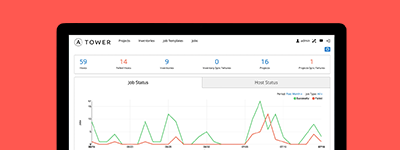ini_file - Tweak settings in INI files
Synopsis
Manage (add, remove, change) individual settings in an INI-style file without having to manage the file as a whole with, say, template or assemble. Adds missing sections if they don’t exist. Before version 2.0, comments are discarded when the source file is read, and therefore will not show up in the destination file.
Requirements (on host that executes module)
- ConfigParser
Options
| parameter | required | default | choices | comments |
|---|---|---|---|---|
| backup |
no | no |
|
Create a backup file including the timestamp information so you can get the original file back if you somehow clobbered it incorrectly. |
| dest |
yes | Path to the INI-style file; this file is created if required | ||
| group |
no | name of the group that should own the file/directory, as would be fed to chown | ||
| mode |
no | mode the file or directory should be. For those used to /usr/bin/chmod remember that modes are actually octal numbers (like 0644). Leaving off the leading zero will likely have unexpected results. As of version 1.8, the mode may be specified as a symbolic mode (for example, u+rwx or u=rw,g=r,o=r). | ||
| option |
no | if set (required for changing a value), this is the name of the option. May be omitted if adding/removing a whole section. | ||
| others |
no | all arguments accepted by the file module also work here | ||
| owner |
no | name of the user that should own the file/directory, as would be fed to chown | ||
| section |
yes | Section name in INI file. This is added if state=present automatically when a single value is being set. | ||
| selevel |
no | s0 | level part of the SELinux file context. This is the MLS/MCS attribute, sometimes known as the range. _default feature works as for seuser. | |
| serole |
no | role part of SELinux file context, _default feature works as for seuser. | ||
| setype |
no | type part of SELinux file context, _default feature works as for seuser. | ||
| seuser |
no | user part of SELinux file context. Will default to system policy, if applicable. If set to _default, it will use the user portion of the policy if available | ||
| state |
no | present |
|
If set to absent the option or section will be removed if present instead of created. |
| value |
no | the string value to be associated with an option. May be omitted when removing an option. |
Examples
# Ensure "fav=lemonade is in section "[drinks]" in specified file - ini_file: dest=/etc/conf section=drinks option=fav value=lemonade mode=0600 backup=yes - ini_file: dest=/etc/anotherconf section=drinks option=temperature value=cold backup=yes
Notes
Note
While it is possible to add an option without specifying a value, this makes no sense.
Note
A section named default cannot be added by the module, but if it exists, individual options within the section can be updated. (This is a limitation of Python’s ConfigParser.) Either use template to create a base INI file with a [default] section, or use lineinfile to add the missing line.
This is a Core Module
For more information on what this means please read Core Modules
For help in developing on modules, should you be so inclined, please read Community Information & Contributing, Helping Testing PRs and Developing Modules.


